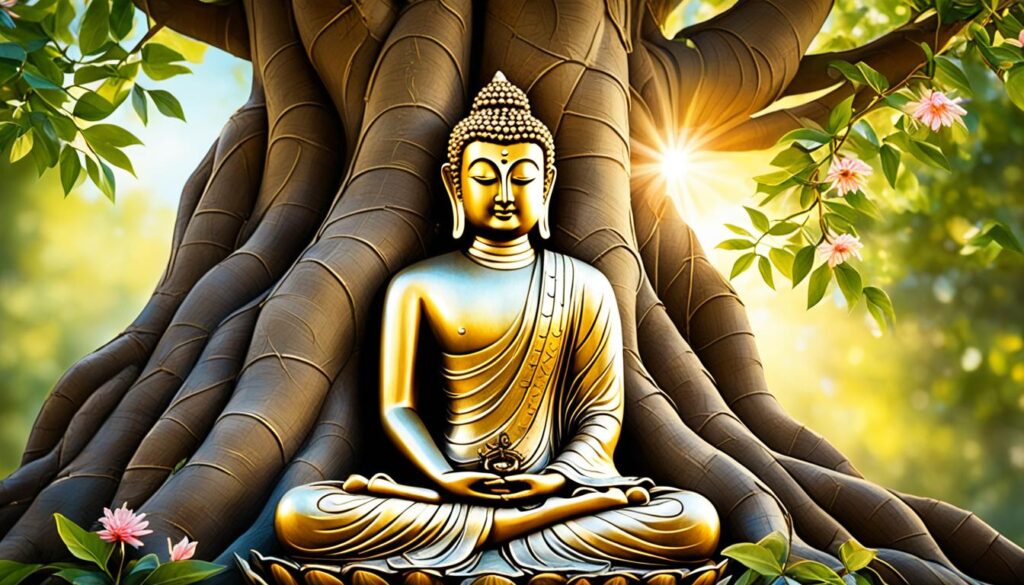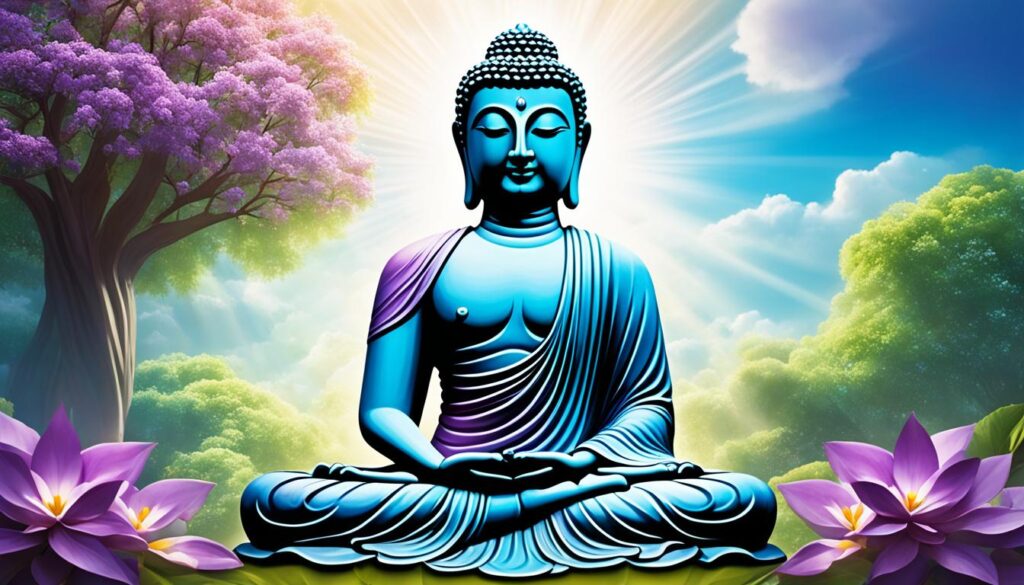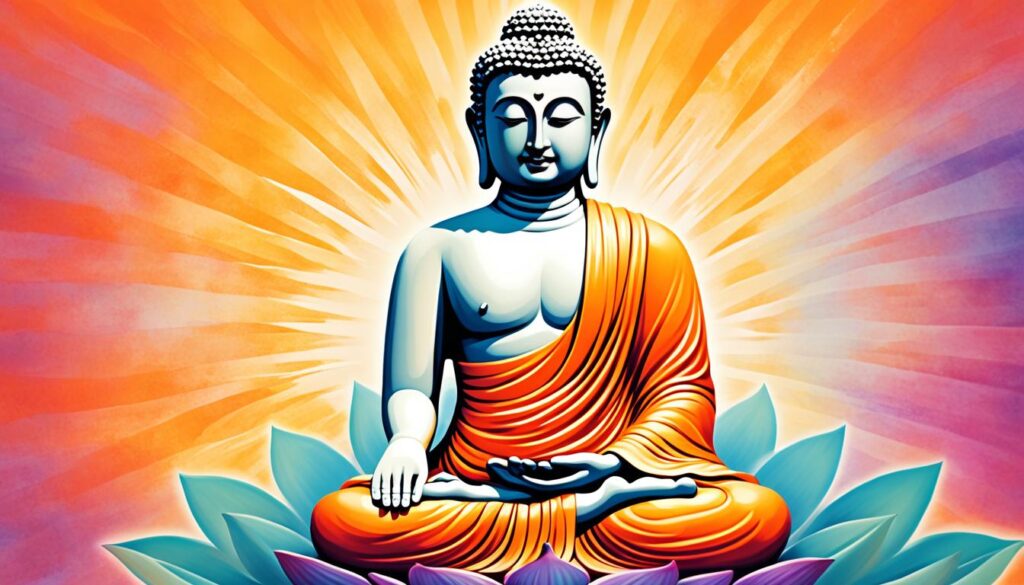When you think of Buddhism, one name comes to mind: Buddha. But who exactly is this enigmatic figure who founded one of the world’s major religions? Is he a god, a philosopher, or simply a wise teacher? The story of Buddha and his teachings are shrouded in mystery and intrigue, captivating the hearts and minds of millions. Dive into the depths of history and discover the truth behind the man who sparked a spiritual revolution.
Throughout this article, we will explore the life and teachings of Buddha, unravel the core principles of Buddhism, and delve into the profound impact his legacy has had on society. Prepare to challenge your preconceptions, expand your understanding, and embark on a journey of enlightenment.
Key Takeaways:
- Siddhartha Gautama, the Buddha, dedicated his life to teaching others about the path to enlightenment and liberation from suffering.
- The Buddha’s teachings emphasize mindfulness, peace, and the importance of balance in achieving personal and societal harmony.
- Understanding the concept of non-self and the law of karma can lead to liberation from attachment and the cycle of rebirth.
- Meditation and mindfulness are integral practices in Buddhism, leading to inner peace and insights into the nature of reality.
- The Dharma, the teachings of the Buddha, provides guidance for leading a virtuous and meaningful life.
The Life and Teachings of Buddha

The Buddha, born in Lumbini, now Nepal, to royal parents, embarked on a spiritual journey to understand the causes of suffering and find a way to alleviate it. Renouncing his privileged life, he dedicated himself to teaching others about the path to enlightenment and liberation from suffering.
Through his profound teachings, the Buddha emphasized the importance of mindfulness and peace in achieving personal and societal harmony. He recognized that by cultivating mindfulness, individuals can develop a deep sense of awareness and presence in the present moment, allowing them to fully engage with their experiences and create inner peace.
Mindfulness, an essential aspect of Buddha’s teachings, involves paying attention to one’s thoughts, feelings, and sensations without judgment. By practicing mindfulness, individuals can become more attuned to their own internal state, cultivating a sense of calm and clarity amidst life’s challenges.
Moreover, the teachings of the Buddha extend beyond the individual level to society as a whole. By promoting mindfulness and peace, the Buddha’s teachings encourage individuals to develop compassion and understanding towards others. This fosters a sense of interconnectedness and harmony, enabling communities to thrive in a spirit of cooperation and empathy.
The Power of Mindfulness
One of the central tenets of the Buddha’s teachings is the transformative power of mindfulness. By cultivating a non-judgmental awareness of one’s thoughts, emotions, and physical sensations, individuals can gain insight into the nature of their own suffering and find freedom from it.
Mindfulness teaches us to observe the arising and passing away of our thoughts and emotions without getting caught up in them. By developing this ability, we can attain a state of inner tranquility and break free from the cycle of reactivity, enabling us to respond to life’s challenges with wisdom and compassion.
The Path to Peace
- Mindfulness: Cultivate present-moment awareness.
- Compassion: Develop empathy and kindness towards oneself and others.
- Wisdom: Gain insights into the nature of reality and the interconnectedness of all beings.
- Non-attachment: Let go of grasping and aversion, finding freedom from suffering.
By following the path laid out by the Buddha, individuals can experience a profound transformation in their lives. The journey towards peace and enlightenment begins with mindfulness and extends to cultivating compassion, wisdom, and non-attachment.
| The Life and Teachings of Buddha | The Core Principles |
|---|---|
| Promoting mindfulness | The Four Noble Truths |
| Fostering peace | The Noble Eightfold Path |
| Emphasizing compassion | The concept of non-self (anatta) |
The Buddha’s teachings continue to resonate with millions of people around the world, inspiring them to live with greater awareness, compassion, and peace. By understanding and integrating his teachings into our lives, we can embark on a transformative journey towards enlightenment and liberation from suffering.
The Core Teachings of Buddha
The Buddha’s core teachings revolve around the Four Noble Truths, which highlight the existence of suffering, its causes, the possibility of its cessation, and the path to its cessation. The path, known as the Noble Eightfold Path, encompasses ethical conduct, mental development, and wisdom. It serves as a guide for individuals seeking enlightenment.
The Four Noble Truths
The Four Noble Truths are at the heart of Buddhist philosophy and provide a framework for understanding the nature of suffering and its eradication. They are:
- Dukkha (Suffering or Unsatisfactoriness): Acknowledging the existence of suffering in the world.
- Samudaya (Origination of Suffering): Recognizing the causes of suffering, such as desire, attachment, and ignorance.
- Nirodha (Cessation of Suffering): Understanding that suffering can be overcome or liberated from.
- Magga (Path to the Cessation of Suffering): Embracing the Noble Eightfold Path to achieve enlightenment and attain freedom from suffering.
The Noble Eightfold Path
The Noble Eightfold Path provides a comprehensive guide for individuals seeking to attain enlightenment and liberation from suffering. It consists of eight interconnected practices:
- Right View: Developing an accurate understanding of reality and the nature of existence.
- Right Intention: Cultivating wholesome intentions and motivations.
- Right Speech: Speaking truthfully, kindly, and in a helpful manner.
- Right Action: Engaging in ethical conduct and avoiding harm to oneself and others.
- Right Livelihood: Choosing a livelihood that is honest and supports a virtuous life.
- Right Effort: Cultivating positive states of mind and abandoning negative ones.
- Right Mindfulness: Cultivating awareness and a focused attention to the present moment.
- Right Concentration: Cultivating deep concentration and mental calm through meditation.
By following the Noble Eightfold Path, individuals can transform their thoughts, words, and actions to achieve personal growth, moral development, and ultimately, enlightenment.

Non-Self and the Concept of Anatta
In Buddhism, the concept of non-self, also known as anatta, is a fundamental teaching of the Buddha. It challenges the notion of a permanent, unchanging self or soul and emphasizes the impermanence and interconnectedness of all things.
The Buddha taught that our sense of self is not an inherent and fixed identity, but rather a collection of constantly changing physical and mental elements. This understanding of non-self is integral to breaking free from attachment, ego, and the cycle of suffering.
By recognizing the selfless nature of existence, individuals can cultivate a deeper sense of interconnectedness and compassion towards all beings. Let go of the illusion of a separate self and embrace the wisdom of anatta for a path towards liberation.

| Key Aspects of Non-Self (Anatta) | Benefits of Embracing Non-Self |
|---|---|
|
|
Karma and Rebirth
In Buddhism, the concept of karma and rebirth plays a crucial role in understanding the nature of existence and the path to liberation. According to the teachings of the Buddha, every action has consequences, forming a chain of cause and effect known as karma. Karma is the principle that virtuous actions lead to positive outcomes, while unwholesome actions result in negative consequences.
The cycle of rebirth, also known as samsara, is seen as the manifestation of the karmic effects of past actions. It is believed that individuals are continuously reborn into different states of existence based on their accumulated karma. This cycle continues until one achieves liberation from the cycle of birth and death, known as enlightenment or nirvana.
Understanding the teachings of karma and rebirth motivates individuals to live ethically and cultivate wholesome actions. By practicing moral conduct and cultivating positive qualities of mind and heart, individuals aim to create a beneficial karmic imprint that leads to a favorable future existence. This understanding also encourages individuals to take responsibility for their actions and strive for personal growth and spiritual development.
The Role of Intention
According to the Buddha, the intention behind an action plays a significant role in determining its karmic consequences. It is not just the external outcome of an action that matters, but the quality of mind and motivation that drives it. Acting with wholesome intentions, such as compassion, generosity, and wisdom, creates positive karma and contributes to one’s spiritual progress.
The Power of Mindfulness
Mindfulness, a key practice in Buddhism, also plays a vital role in understanding and transforming karma. By cultivating present-moment awareness and developing non-judgmental attention, individuals can observe their thoughts, emotions, and actions more clearly. This heightened awareness allows them to navigate life’s challenges with greater wisdom and make choices that are aligned with their values and goals.

| Karma | Rebirth | Cause and Effect |
|---|---|---|
| Every action has consequences, known as karma. | Rebirth is the cycle of continuous existence based on accumulated karma. | Cause and effect govern the karmic outcomes of actions. |
| Virtuous actions lead to positive outcomes. | One’s rebirth is influenced by the quality of their accumulated karma. | Understanding cause and effect motivates individuals to cultivate wholesome actions. |
| Unwholesome actions lead to negative consequences. | The cycle of rebirth continues until liberation is attained. | Intention behind actions plays a crucial role in determining their karmic consequences. |
The Middle Way and the Importance of Balance
In his teachings, the Buddha emphasized the concept of the Middle Way, which encourages individuals to find a balanced approach to life, avoiding the extremes of indulgence and asceticism. By practicing moderation and embodying a sense of balance, you can cultivate inner peace, clarity, and harmony.
The Middle Way advocates for steering clear of excessive indulgence in sensory pleasures, such as overindulging in food, material possessions, or worldly desires. While satisfying basic needs and enjoying life’s pleasures is natural and necessary, excessive attachment to these indulgences can hinder spiritual growth and ultimately lead to suffering.
On the other hand, extreme asceticism, renouncing all worldly pleasures, can also be detrimental. The Buddha himself experienced this firsthand. Before attaining enlightenment, he followed a path of extreme self-denial, nearly starving himself in pursuit of spiritual realization. However, he realized that this extreme approach did not lead to awakening but instead weakened his physical and mental state.
By stepping onto the Middle Way, you acknowledge the importance of balance. It involves finding a middle ground that promotes a sense of well-being, peace, and contentment. Instead of becoming attached to temporary pleasures or denying yourself of necessary joys, you strive to find a harmonious equilibrium.
The Middle Way extends beyond material aspects and encompasses all facets of life, including relationships, work, and personal pursuits. It encourages you to navigate through life with mindfulness and conscious decision-making. By embracing moderation, you can develop a greater sense of self-awareness and clarity

Meditative Practices and Mindfulness
Meditation and mindfulness are integral components of Buddhist practice. The teachings of the Buddha emphasize the importance of these practices in cultivating inner peace and gaining insights into the nature of reality.
The Buddha, in his wisdom, encouraged his followers to engage in meditation to develop mindfulness, concentration, and awareness. By sitting in meditation, you can quiet the mind, observe your thoughts without judgment, and deepen your connection to the present moment.
This practice of mindfulness allows you to be fully present, focusing your attention on the sensations of the body, the breath, and the thoughts and emotions that arise. Through sustained practice, you can develop a greater sense of self-awareness and gain clarity on the workings of the mind.
Mindfulness not only has profound effects on your mental well-being but also enhances your ability to navigate the challenges of daily life. By developing a non-judgmental and accepting attitude toward your experiences, you can cultivate a greater sense of peace, resilience, and equanimity.
With regular practice, meditation and mindfulness can lead to a deep sense of inner peace, as well as insights into the interconnectedness of all beings and the impermanence of existence. These practices allow you to tap into your inner wisdom and cultivate a compassionate and empathetic outlook on life.

The Dharma and its Importance
The Dharma, meaning the teachings of the Buddha, holds immense significance in the Buddhist tradition. It encompasses the profound insights of the Buddha into the nature of existence and provides guidance for leading a virtuous and meaningful life. The Dharma serves as a treasury of wisdom, illuminating the path towards enlightenment.
As the embodiment of wisdom and compassion, the Buddha’s teachings offer transformative insights that resonate across time and cultures. They provide a roadmap for understanding the human condition, overcoming suffering, and attaining liberation.
The Dharma encompasses a vast array of teachings, encompassing various aspects of human existence and spiritual development. It encompasses ethical conduct, mindfulness, meditation practices, and profound insights into the nature of reality.
At the core of the Dharma are the Four Noble Truths, which reveal the truths of suffering, its causes, the possibility of its cessation, and the path leading to liberation from suffering. These teachings emphasize the impermanent and interconnected nature of existence, guiding individuals towards a deeper understanding of themselves and the world.
Through engaging with the Dharma, individuals gain access to ancient wisdom that transcends the boundaries of time and space. The Dharma invites introspection, reflection, and contemplation, encouraging individuals to critically examine their thoughts, emotions, and actions. By cultivating wisdom and compassion, one can transform their lives and contribute to the greater well-being of society.
The Three Jewels of Buddhism
Central to the Buddhist tradition is the concept of taking refuge in the Three Jewels: the Buddha, the Dharma, and the Sangha. The Dharma, in this context, represents the teachings of the Buddha as the ultimate source of guidance and insight.
| Key Aspects of the Dharma | Explanation |
|---|---|
| Universal Truths | The Dharma encompasses timeless truths about the nature of existence, human suffering, and the path to liberation. |
| Ethical Conduct | The Dharma provides guidelines for living a moral and virtuous life, emphasizing compassion, honesty, and respect for all beings. |
| Mental Development | The Dharma offers meditation practices and techniques to cultivate mindfulness, concentration, and insight, promoting inner peace and clarity. |
| Wisdom | Through the study and contemplation of the Dharma, individuals develop wisdom and gain insights into the true nature of reality. |
The Dharma is not confined to an intellectual pursuit but must be put into practice to fully realize its transformative potential. By integrating the teachings into daily life and embodying their principles, individuals can live in harmony with themselves and the world around them.

Buddhism’s Impact on Society
Buddhism’s teachings have had a profound impact on society. The practice of mindfulness and compassion promotes empathy, kindness, and social harmony. Buddhist values emphasize the importance of treating others with respect and compassion, which can contribute to creating a more peaceful and just world.
Mindfulness: Cultivating Awareness and Well-Being
Mindfulness is a fundamental aspect of Buddhist practice and has gained significant recognition in modern society. By cultivating awareness of the present moment without judgment, individuals can develop a deeper understanding of themselves and their surroundings. Mindfulness allows us to appreciate the beauty of each moment and brings a sense of calm and clarity to our everyday lives. Research has shown that mindfulness-based practices can reduce stress, improve mental health, and enhance overall well-being.
Compassion: Fostering Connection and Empathy
Compassion is the heart of Buddhism, and its teachings inspire individuals to extend kindness and understanding towards others. By cultivating compassion, we develop a deep sense of connection and empathy for all beings, promoting harmony in relationships and communities. Compassion encourages acts of altruism and encourages individuals to contribute to the welfare of others. This spirit of compassion is essential for building a more inclusive and caring society.
| Mindfulness | Compassion |
|---|---|
| Promotes self-awareness and emotional well-being | Fosters connection and empathy |
| Reduces stress and enhances mental health | Inspires acts of kindness and altruism |
| Cultivates a sense of calm and clarity | Contributes to social harmony and peace |
The practice of mindfulness and compassion goes beyond the individual level and extends to the broader society. It encourages people to recognize the interconnectedness of all beings and to work towards the well-being of humanity as a whole. By embodying these principles, we can contribute to the creation of a more compassionate, just, and mindful society.

Buddhism and Modern Challenges
In today’s fast-paced and demanding world, many individuals encounter various modern challenges that can impact their well-being. Stress and mental health have become prevalent concerns affecting countless people. Recognizing the need for holistic solutions, Buddhism offers valuable insights and practices to address these contemporary issues.
At the core of Buddhist teachings lies the practice of mindfulness, which can help individuals cultivate resilience and cope with the pressures of modern life. By paying attention to the present moment and embracing a non-judgmental awareness of their thoughts and emotions, practitioners develop a deeper understanding of themselves and their surroundings.
The act of being fully present in each moment allows individuals to develop a stronger sense of self-awareness and reduce stress. Through mindfulness, one can observe their thoughts and feelings without becoming overwhelmed by them, thereby reducing anxiety and promoting mental well-being.
The Power of Mindfulness
Mindfulness provides a pathway to inner peace and tranquility. By focusing on the present moment, practitioners can let go of worries about the past or future, allowing them to find solace in the present. This practice encourages individuals to accept themselves and their experiences, fostering self-compassion and reducing self-criticism.
Removing judgment and cultivating a compassionate attitude towards oneself promotes a positive mindset, thus alleviating stress and improving mental health. Integrating mindfulness into daily life can enhance overall well-being and provide a sense of peace amidst the chaos of modern challenges.
Environmental Stewardship and Social Justice
Buddhist principles go beyond personal well-being and extend to addressing broader contemporary challenges, such as environmental issues and social justice. Buddhism emphasizes the interconnectedness of all beings and the responsibility to care for the natural world.
By promoting environmental stewardship and mindfulness of our impact on the planet, Buddhism encourages individuals to adopt sustainable habits, reduce consumption, and work towards a more harmonious relationship with nature.

Additionally, Buddhism advocates for social justice and equality. The teachings emphasize compassion, kindness, and treating others with respect. By promoting these values, Buddhism fosters a more inclusive and just society where individuals support one another and work towards collective well-being.
Final Thoughts
Buddhism offers invaluable guidance for navigating the modern challenges of stress and mental health. Through the practice of mindfulness and the integration of Buddhist principles into daily life, individuals can cultivate resilience, find inner peace, and contribute to a more sustainable and compassionate society.
The Spread of Buddhism
Buddhism, originating in India, transcended its borders and spread throughout the world, becoming a global religion renowned for its profound teachings and practices. The spread of Buddhism had far-reaching effects, giving rise to diverse traditions and impacting various aspects of cultural life, including art, architecture, literature, and philosophy.
Art and Architecture: The spread of Buddhism led to the development of magnificent artistic and architectural styles that showcased the influence of Buddhist beliefs and values. From intricate sculptures to grand temples adorned with symbolic imagery, Buddhist art and architecture reflected the devotion and spirituality of the followers.
Literature and Philosophy: Buddhist teachings inspired an extensive body of literature, focusing on spiritual insights, moral principles, and philosophical contemplations. Sacred texts such as the Tripitaka and the Mahayana sutras played a vital role in disseminating Buddhist knowledge and shaping intellectual discourse.
| Aspect | Impact |
|---|---|
| Art and Architecture | Buddhist art and architecture showcased the influence of Buddhist beliefs and values, leaving a lasting cultural impact. |
| Literature and Philosophy | Buddhist teachings inspired an extensive body of literature and philosophical contemplations, shaping intellectual discourse. |
The cultural impact of Buddhism can still be witnessed in various regions where it took root and flourished. The fusion of Buddhist principles with local customs and beliefs produced a rich tapestry of traditions, rituals, and cultural expressions that continue to exist to this day.

The global spread of Buddhism allowed for the exchange of ideas, cultural integration, and the formation of new practices within different societies. This interplay of diverse cultural influences contributed to the formation of unique Buddhist traditions around the world.
The enduring cultural impact of Buddhism serves as a testament to the universal resonance of its teachings. The profound spiritual insights and ethical principles continue to inspire individuals and communities, promoting peace, compassion, and inner transformation.
Iconography and Depictions of Buddha
The life and teachings of the Buddha have inspired a rich artistic tradition, capturing his essence through various forms of iconography. From statues and paintings to intricate sculptures and symbolic imagery, depictions of the Buddha convey spiritual and philosophical messages and serve as objects of reverence and inspiration.
The art of Buddhist iconography is deeply rooted in symbolism, aiming to encapsulate the essence of the Buddha’s teachings and the qualities he represents. Every aspect of the depictions, from hand gestures (mudras) to facial expressions, postures, and clothing, carries profound meaning.
![]()
The iconography of the Buddha can vary across different Buddhist traditions, reflecting the diverse cultural influences and interpretations. In Theravada Buddhism, the Buddha is commonly depicted in a seated position, known as the “earth-touching” or “calling the earth to witness” posture. This gesture represents the moment of the Buddha’s enlightenment when he called upon the earth as his witness.
In Mahayana Buddhism, depictions of the Buddha often showcase compassion and a connection to all sentient beings. The most common representation is that of the “meditation” or “teaching” posture, where the Buddha is seated with one hand resting on the lap and the other hand raised in a gesture of reassurance or teaching.
Beyond the physical appearance, the intricate details of Buddha iconography hold deep symbolism. Different hand gestures symbolize qualities such as wisdom, fearlessness, compassion, or protection. The facial expressions convey serenity, equanimity, and inner tranquility, reflecting the Buddha’s attainment of enlightenment.
The clothing and ornaments worn by the Buddha in the depictions also carry symbolic significance. The simple and flowing robes represent detachment from material possessions and worldly desires, while the jewelry and ornamentation reflect spiritual adornments and enlightened qualities.
Throughout history, artists have used various mediums to depict the Buddha, each with its unique artistic style and cultural influences. Sculptures made of stone, wood, or metal capture the three-dimensional beauty and grace of the Buddha. Paintings, such as the vibrant thangka art in Tibetan Buddhism, offer intricate details and vibrant colors that bring the Buddha’s teachings to life.
Symbolism in Buddhist art goes beyond visual representations. It extends to the colors used, the patterns, and even the materials themselves. For example, gold symbolizes enlightenment and wisdom, while blue represents purity and compassion.
As objects of reverence and inspiration, these artistic depictions of the Buddha invite practitioners to connect with his teachings and cultivate the qualities he embodies, such as mindfulness, compassion, and wisdom. They serve as reminders of the path towards liberation and enlightenment, encouraging individuals to embark on their own spiritual journey.
Recognizing Buddha’s Legacy
The legacy of the Buddha extends far and wide, leaving a lasting impact on humanity. His teachings continue to inspire millions of people worldwide to embark on a transformative journey of mindfulness, compassion, and peace.
By embracing the principles of Buddhism, individuals can cultivate inner awareness and understanding, leading to personal transformation and the ability to contribute to a more harmonious and compassionate society.
Benefits of Buddha’s Teachings:
- Mindfulness: The Buddha emphasized the practice of mindfulness, the ability to be fully present in the moment, aware of one’s thoughts, feelings, and sensations. This practice fosters self-awareness, reduces stress, and promotes overall well-being.
- Compassion: The teachings of the Buddha encourage the development of compassion towards oneself and others. By cultivating empathy and kindness, individuals can foster harmonious relationships and contribute to a more peaceful world.
- Inner Peace: Through practicing the Buddha’s teachings, individuals can attain a sense of inner peace and tranquility. By letting go of attachments and embracing impermanence, one can find serenity amidst the challenges of life.
By recognizing the legacy of the Buddha and integrating his teachings into our lives, we can strive towards personal growth and societal harmony, creating a world filled with mindfulness, compassion, and peace.

Acknowledging the Influence
The profound influence of the Buddha’s legacy is evident in the widespread practice of mindfulness and the emphasis on compassion in various cultures and communities. As his teachings continue to resonate, the impact of the Buddha’s legacy extends beyond borders, inspiring individuals to lead lives filled with wisdom, kindness, and harmony.
Conclusion
The legacy of Buddha, the founder of Buddhism, is etched in the hearts and minds of individuals seeking spiritual and philosophical guidance. His profound teachings of mindfulness, peace, and enlightenment continue to inspire and transform lives.
Through his insights into the nature of existence, Buddha provided a path to liberation from suffering. His wisdom offers profound guidance for personal and societal transformation, transcending time and reaching people from all walks of life.
As his teachings spread across the globe, the enduring impact of Buddha’s legacy is evident in the pursuit of peace, compassion, and awakening. From the ancient teachings to the present, his profound influence resonates with those who seek inner peace, understanding, and enlightenment.
FAQ
Who is Buddha?
Buddha, also known as Siddhartha Gautama, is the founder of Buddhism. He lived in South Asia during the 6th or 5th century BCE and dedicated his life to teaching others about the path to enlightenment and liberation from suffering.
What are the core teachings of Buddha?
The core teachings of Buddha revolve around the Four Noble Truths and the Noble Eightfold Path. The Four Noble Truths highlight the existence of suffering, its causes, the possibility of its cessation, and the path to its cessation. The Noble Eightfold Path encompasses ethical conduct, mental development, and wisdom, serving as a guide for individuals seeking enlightenment.
What is the concept of non-self in Buddhism?
The concept of non-self, or anatta, is a central teaching in Buddhism. It emphasizes that there is no permanent, unchanging self or soul. Instead, individuals are composed of constantly changing physical and mental elements. Understanding the non-self nature of existence is essential for breaking free from attachment and suffering.
What is karma in Buddhism?
Karma is the law of cause and effect in Buddhism. It teaches that actions have consequences, where virtuous actions lead to positive outcomes and unwholesome actions lead to negative ones. The cycle of rebirth, or samsara, is seen as the result of past actions. Understanding these teachings motivates individuals to live ethically and strive for liberation.
What is the Middle Way in Buddhism?
The Middle Way is a teaching advocated by Buddha, which emphasizes avoiding extreme indulgence as well as extreme asceticism. It encourages finding a balanced approach to life. By practicing moderation and avoiding extremes, individuals can cultivate inner peace and clarity.
What is the role of meditation and mindfulness in Buddhism?
Meditation and mindfulness are integral components of Buddhist practice. Buddha encouraged his followers to engage in meditation to cultivate mindfulness, concentration, and awareness. Through these practices, individuals can develop a deep sense of inner peace and gain insights into the nature of reality.
What is the Dharma in Buddhism?
The Dharma refers to the teachings of Buddha. It encompasses his insights into the nature of existence and provides guidance for leading a virtuous and meaningful life. The Dharma serves as a source of wisdom and a path towards enlightenment.
How has Buddhism impacted society?
Buddhism’s practice of mindfulness and compassion promotes empathy, kindness, and social harmony. Its values emphasize treating others with respect and compassion, contributing to creating a more peaceful and just world.
How does Buddhism address modern challenges?
Buddhism’s teachings, such as mindfulness, can help individuals cultivate resilience and cope with the pressures of modern life. Buddhist principles also promote environmental stewardship and social justice, addressing contemporary issues.
How did Buddhism spread beyond its origins?
Buddhism spread beyond its origins in India and became a global religion. It flourished in various countries, giving rise to different traditions and practices. The spread of Buddhism influenced art, architecture, literature, and philosophy, leaving a lasting cultural impact on the regions where it took root.
What is the significance of Buddha’s iconography?
The life and teachings of Buddha have inspired a rich artistic tradition. Depictions of the Buddha through various forms of iconography, such as statues, paintings, and sculptures, convey spiritual and philosophical messages. They also serve as objects of reverence and inspiration.
What is Buddha’s legacy?
Buddha’s teachings continue to inspire millions of people worldwide to cultivate mindfulness, compassion, and peace. His insights into the nature of existence and the path to liberation from suffering offer profound wisdom for personal and societal transformation.

